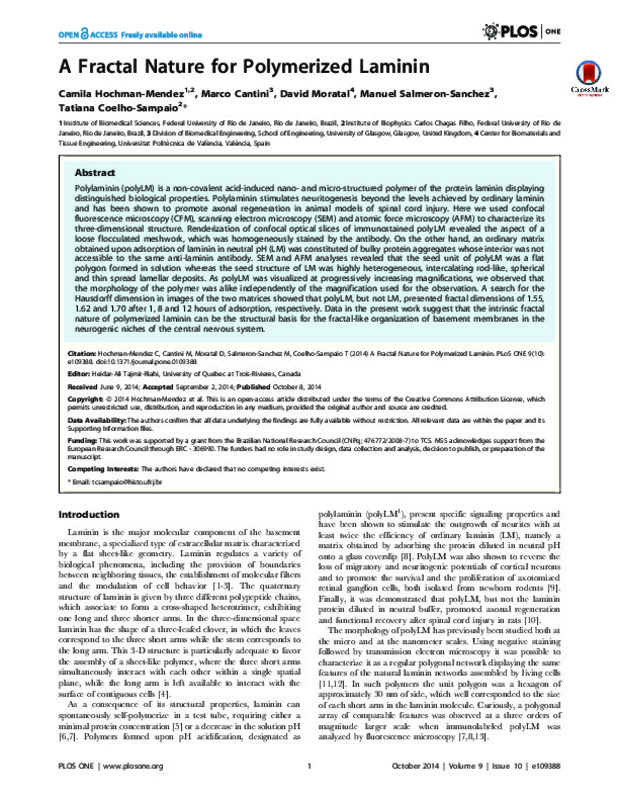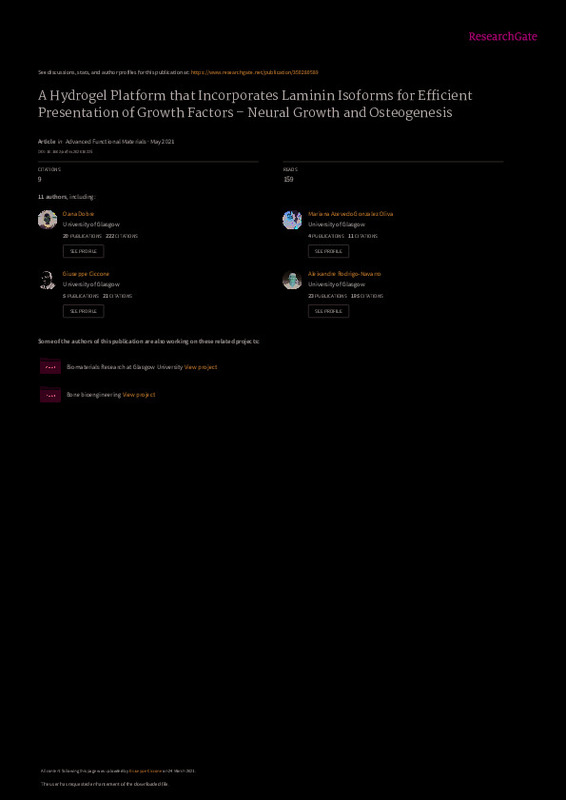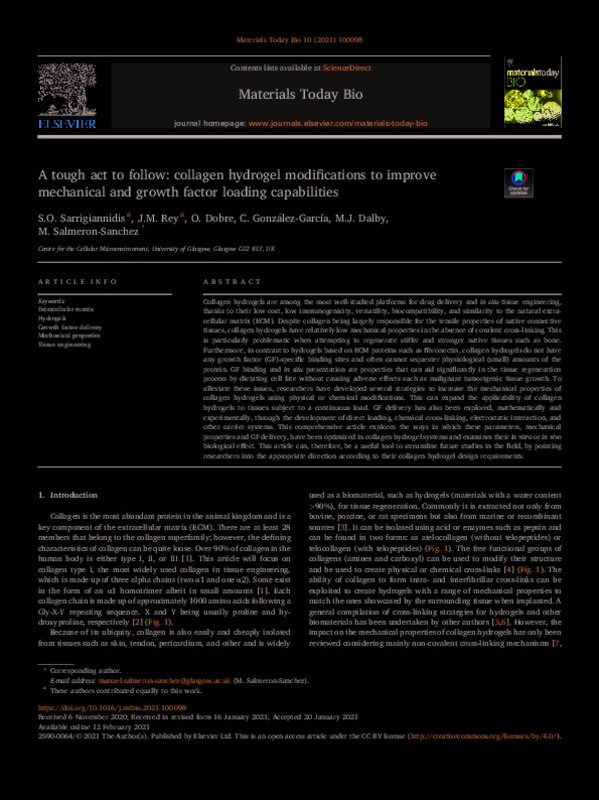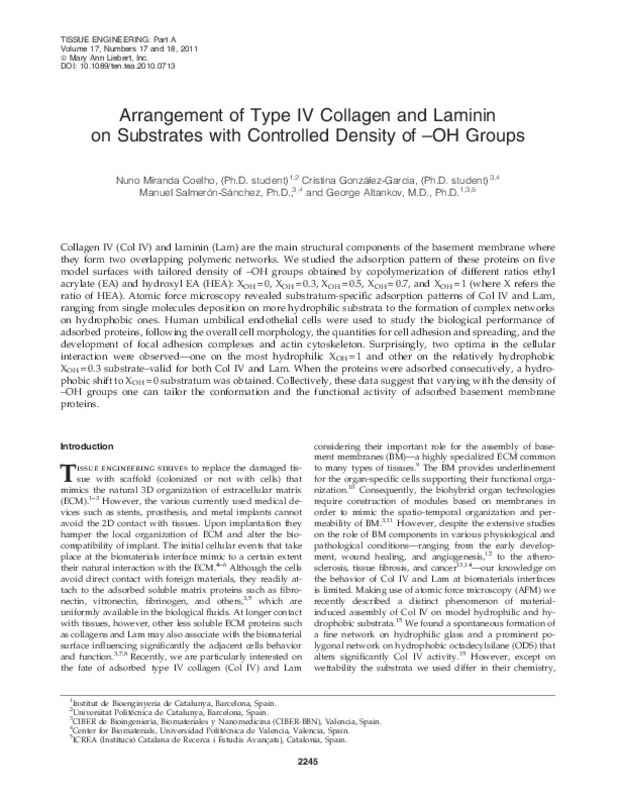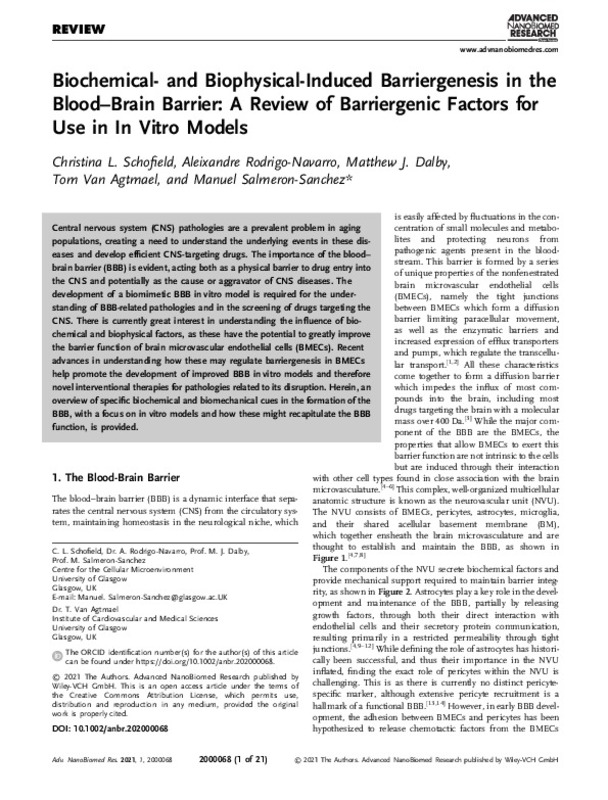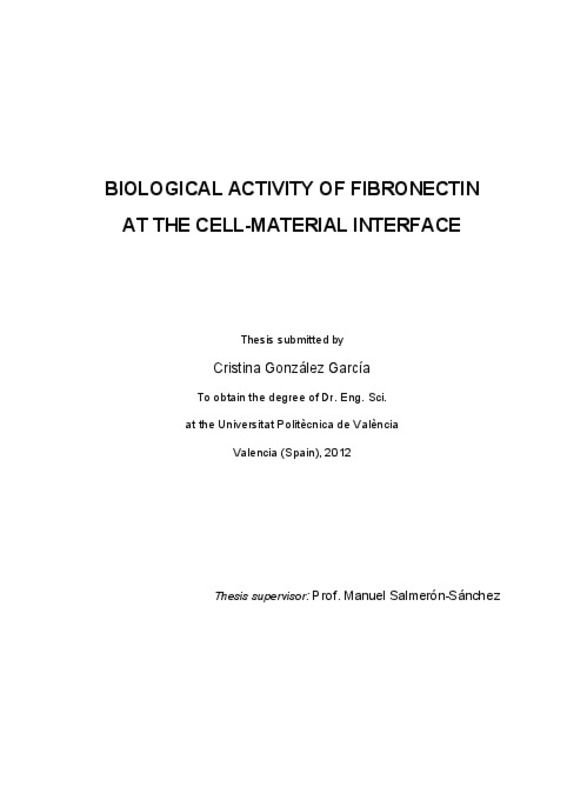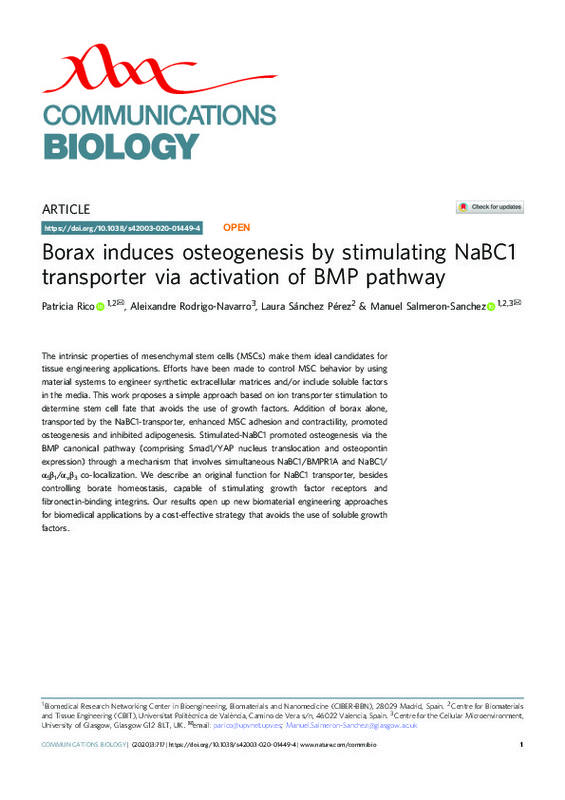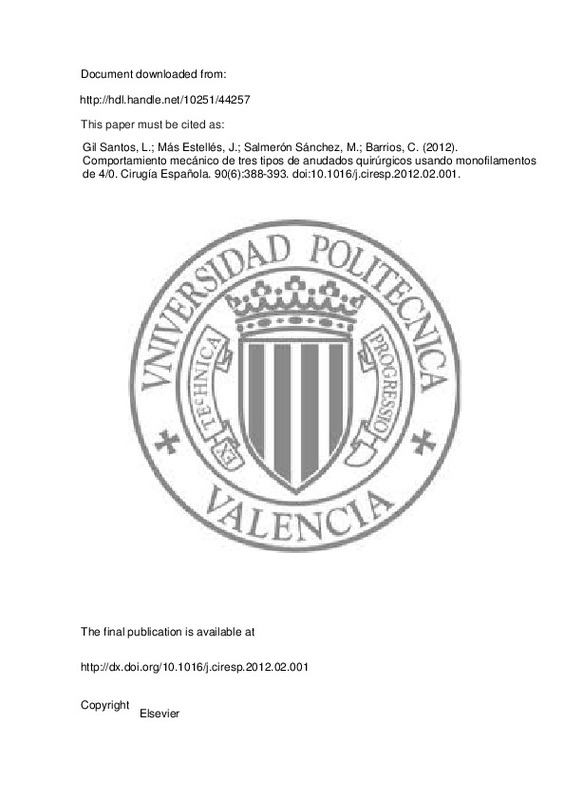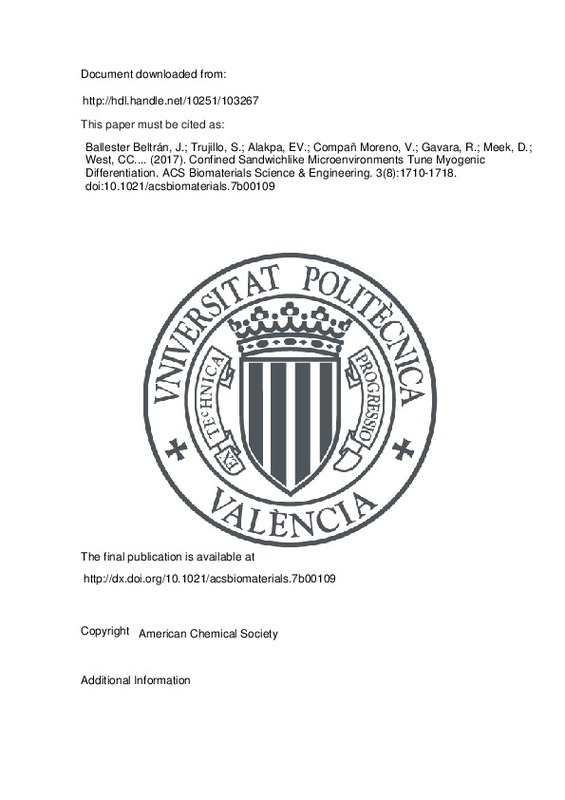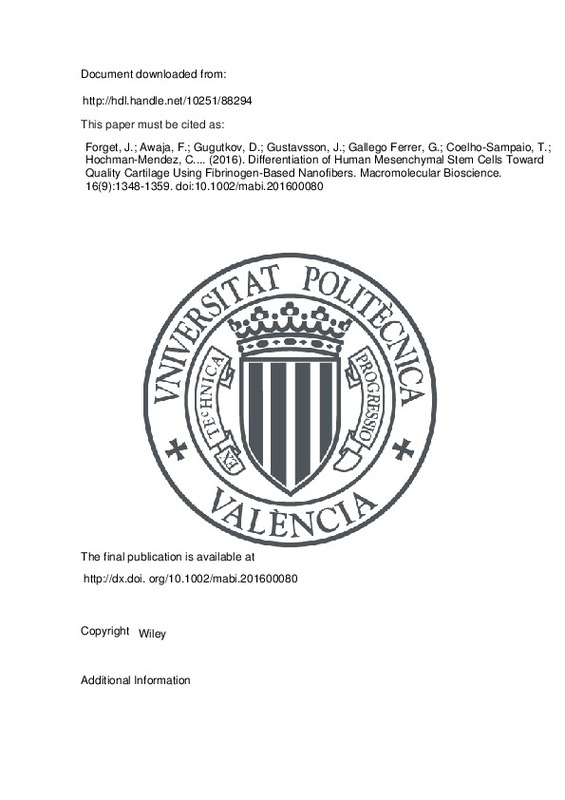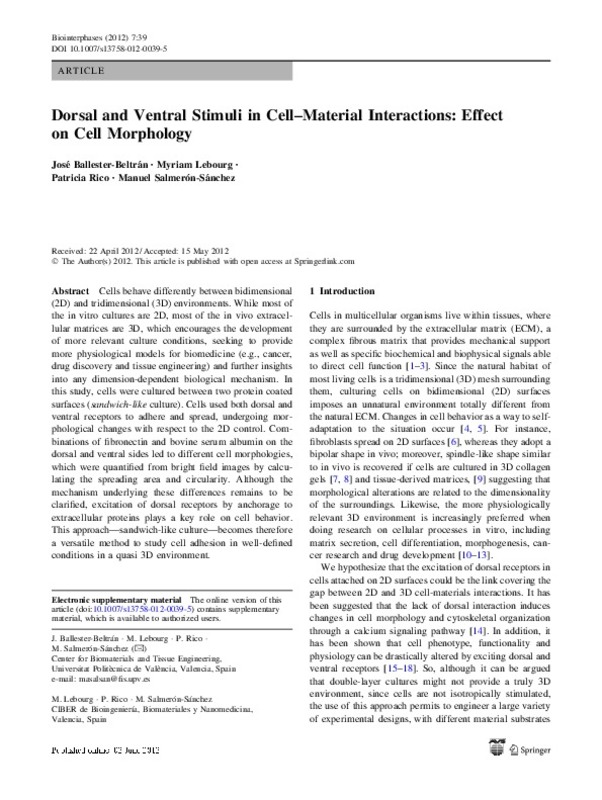

Listar por autor "Salmerón Sánchez, Manuel"
RiuNet: Repositorio Institucional de la Universidad Politécnica de Valencia
- RiuNet repositorio UPV
- :
- Listar por autor
JavaScript is disabled for your browser. Some features of this site may not work without it.
Buscar en RiuNet
Listar
Mi cuenta
Ayuda RiuNet
Admin. UPV
Listar por autor "Salmerón Sánchez, Manuel"
Mostrando ítems 1-20 de 79
-
Hochman Méndez, Carlos; Cantini ., Marco; Moratal Pérez, David; Salmerón Sánchez, Manuel; Coelho-Sampaio, Tatiana (Public Library of Science, 2014-10)Polylaminin (polyLM) is a non-covalent acid-induced nano- and micro-structured polymer of the protein laminin displaying distinguished biological properties. Polylaminin stimulates neuritogenesis beyond the levels achieved ...
-
Dobre, Oana; Oliva, Mariana A. G.; Ciccone, Giuseppe; Trujillo-Muñoz, Sara; Rodrigo Navarro, Aleixandre; Venters, Douglas Cormac; Llopis Hernández, Virginia; Vassalli, Massimo; González García, Cristina; Dalby, Matthew J.; Salmerón Sánchez, Manuel (John Wiley & Sons, 2021-05)[EN] Laminins (LMs) are important structural proteins of the extracellular matrix (ECM). The abundance of every LM isoform is tissue-dependent, suggesting that LM has tissue-specific roles. LM binds growth factors (GFs), ...
-
Sarrigiannidis, S.O.; Rey, J. M.; Dobre, O .; González-García, C.; Dalby, M.J.; Salmerón Sánchez, Manuel (Elsevier, 2021-03)[EN] Collagen hydrogels are among the most well-studied platforms for drug delivery and in situ tissue engineering, thanks to their low cost, low immunogenicity, versatility, biocompatibility, and similarity to the natural ...
-
Coelho, Nuno Miranda; González García, Cristina; Salmerón Sánchez, Manuel; Altankov, George (Mary Ann Liebert, 2011)Collagen IV (Col IV) and laminin (Lam) are the main structural components of the basement membrane where they form two overlapping polymeric networks. We studied the adsorption pattern of these proteins on five model ...
-
Miranda Coelho, Nuno; González García, Cristina; Salmerón Sánchez, Manuel; Altankov, George (Wiley-Blackwell, 2011-07)Apart from the paradigm that cell-biomaterials interaction depends on the adsorption of soluble adhesive proteins we anticipate that upon distinct conditions also other, less soluble ECM proteins such as collagens, associate ...
-
Schofield, Christina L.; Rodrigo-Navarro, Aleixandre; Dalby, Matthew J.; Van Agtmael, Tom; Salmerón Sánchez, Manuel (Wiley-VCH Verlag GmbH & Co. KGaA, 2021-05)[EN] Central nervous system (CNS) pathologies are a prevalent problem in aging populations, creating a need to understand the underlying events in these diseases and develop efficient CNS-targeting drugs. The importance ...
-
Escobar Ivirico, Jorge Luis; Salmerón Sánchez, Manuel; Gómez Ribelles, José Luís; Monleón Pradas, Manuel (Wiley, 2011)New biodegradable block copolymer networks were synthesized from methacrylate-terminated poly(L-lactide) (mLA) and polycaprolactone (mCL) macromers. This allowed the realization of a series of materials in which the macromer ...
-
González García, Cristina (Universitat Politècnica de València, 2012-11-05)Esta tesis aborda la actividad biológica de la fibronectina (FN) como proteína de interfase en la interacción célula-material. La tesis investiga la respuesta de la proteína, en términos de cantidad adsorbida y conformación, ...
-
Gugutkov, Dencho; González-García, Cristina; Rodríguez Hernández, José Carlos; Altankov, George; Salmerón Sánchez, Manuel (American Chemical Society, 2009)[EN] Fibronectin (FN) fibrillogenesis is a cell-mediated process involving integrin activation that results in conformational changes of FN molecules and the organization of actin cytoskeleton. A similar process can be ...
-
Gavazzo, Paola; Viti, Federica; Donnelly, Hannah; Gonzalez Oliva, Mariana Azevedo; Salmerón Sánchez, Manuel; Dalby, Matthew J.; Vassalli, Massimo (Springer-Verlag, 2021-12)[EN] Mesenchymal stem cells represent an important resource, for bone regenerative medicine and therapeutic applications. This review focuses on new advancements and biophysical tools which exploit different physical and ...
-
Rico Tortosa, Patricia María; Rodrigo Navarro, Aleixandre; Sánchez-Pérez, Laura; Salmerón Sánchez, Manuel (Springer Nature, 2020-11-27)[EN] The intrinsic properties of mesenchymal stem cells (MSCs) make them ideal candidates for tissue engineering applications. Efforts have been made to control MSC behavior by using material systems to engineer synthetic ...
-
Gamboa Martínez, Tatiana Carolina; Ródenas Rochina, Joaquín; Rico Tortosa, Patricia María; Lebourg, Myriam Madeleine; Gómez Ribelles, José Luís; Salmerón Sánchez, Manuel; Gallego-Ferrer, Gloria (American Scientific Publishers, 2013)[EN] The aim of this study was to evaluate whether mechanical stimulation helps to modulate the redifferentiation of human chondrocytes on adhesive 3D substrates. In a previous work, it was shown that chondrocytes seeded ...
-
Gil Santos, Luis; Más Estellés, Jorge; Salmerón Sánchez, Manuel; Barrios, Carlos (Elsevier, 2012-07)[ES] Objetivo Estudiar experimentalmente mediante ensayos mecánicos el comportamiento de 4 tipos de monofilamento con 3 diseños de nudo, muy frecuentemente utilizados en cirugía. Material y métodos Se eligieron 4 ...
-
Ballester Beltrán, José; Trujillo, Sara; Alakpa, Enateri V.; Compañ Moreno, Vicente; Gavara, Rafael; Meek, Dominic; West, Christopher C.; Peault, Bruno; Dalby, Matthew J.; Salmerón Sánchez, Manuel (American Chemical Society, 2017)[EN] Sandwichlike (SW) cultures are engineered as a multilayer technology to simultaneously stimulate dorsal and ventral cell receptors, seeking to mimic cell adhesion in three-dimensional (3D) environments in a reductionist ...
-
Cantos Gómez, Antonio (Universitat Politècnica de València, 2013-12-10)Consulta en la Biblioteca ETSI Industriales (7872)
-
MNATSAKANYAN, HAYK; Rico Tortosa, Patricia María; Grigoriou, Eleni; Maturana Candelas, Aarón; Rodrigo Navarro, Aleixandre; Salmerón Sánchez, Manuel; Sabater i Serra, Roser (American Chemical Society, 2015-08-19)Fibronectin fibrillogenesis is the physiological process by which cells elaborate a fibrous FN matrix. Poly(ethyl acrylate), PEA, has been described to induce a similar process upon simple adsorption of fibronectin (FN) ...
-
Cantini, Marco; Rico Tortosa, Patricia María; Moratal Pérez, David; Salmerón Sánchez, Manuel (Royal Society of Chemistry, 2012)Plasma polymerization was used to produce novel nanometric coatings able to direct fibronectin adsorption and cell response. Using ethyl acrylate as a monomer, we obtain coatings whose chemical composition maintains some ...
-
Hernández Saz, Jesús (Universitat Politècnica de València, 2013-12-10)Consulta en la Biblioteca ETSI Industriales (7864)
-
Forget, Jeremy; Awaja, Firas; Gugutkov, Dencho; Gustavsson, Juhan; Gallego-Ferrer, Gloria; Coelho-Sampaio, Tatiana; Hochman-Mendez, Camila; Salmerón Sánchez, Manuel; Altankov, George (Wiley, 2016-09)[EN] Mimicking the complex intricacies of the extra cellular matrix including 3D configurations and aligned fibrous structures were traditionally perused for producing cartilage tissue from stem cells. This study shows ...
-
Ballester Beltrán, José; Lebourg, Myriam Madeleine; Rico Tortosa, Patricia María; Salmerón Sánchez, Manuel (American Vacuum Society, 2012-06)Cells behave differently between bidimensional (2D) and tridimensional (3D) environments. While most of the in vitro cultures are 2D, most of the in vivo extracellular matrices are 3D, which encourages the development of ...
Mostrando ítems 1-20 de 79

Universitat Politècnica de València. Unidad de Documentación Científica de la Biblioteca (+34) 96 387 70 85 · RiuNet@bib.upv.es


